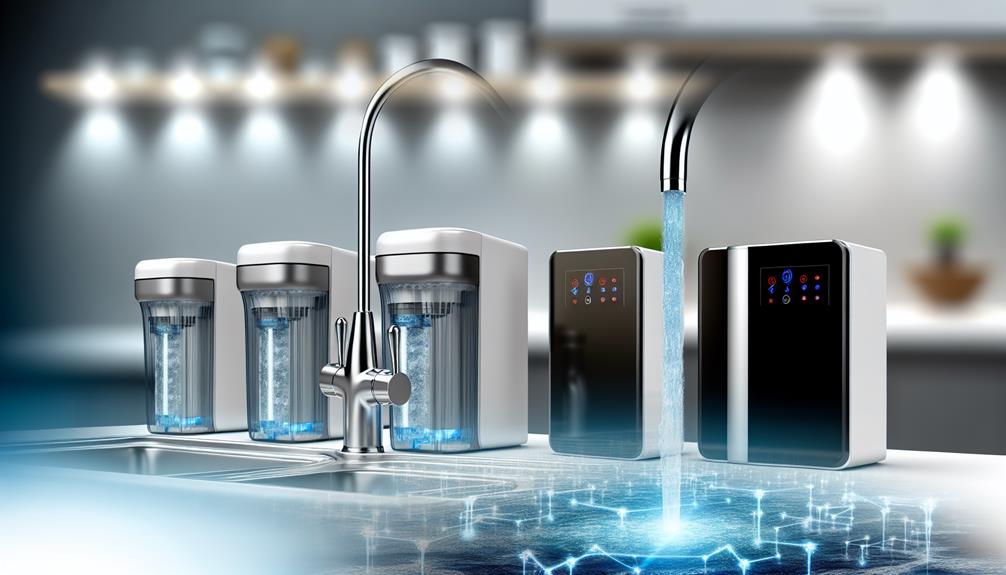Nearly 2.2 billion people globally lack access to safely managed drinking water, a statistic that underscores the critical need for sustainable water filtration solutions. You're undoubtedly aware that clean water is essential for health, economic development, and environmental sustainability.
As you explore the top six innovations in sustainable water filtration, you'll encounter cutting-edge technologies that are transforming access to potable water. From advanced membrane bioreactors to forward osmosis desalination, these innovations not only promise to filter water more efficiently but also do so in an eco-friendly manner. Each system offers unique advantages that could revolutionize water purification, addressing the pressing demands of water-scarce regions.
Now, consider the potential impact on communities worldwide as these technologies gain traction, and ask yourself how they might fit into the broader landscape of environmental conservation and resource management.
Advanced Membrane Bioreactors
Advanced Membrane Bioreactors, spearheading the evolution of water treatment, integrate nanocomposite membranes and innovative configurations to boost purification while slashing energy use. You're witnessing a pivotal shift in filtration systems, where the synergy of advanced water technologies culminates in unparalleled wastewater treatment solutions. These reactors aren't only pivotal for innovative water purification but also for ensuring the sustainability of safe drinking water supplies.
Nanocomposite membranes, the heart of these systems, provide superior selectivity and demonstrate remarkable resistance to fouling—a common challenge in conventional purification processes. This resilience translates into longer system life spans and reduced maintenance costs. Meanwhile, the innovative module configurations are meticulously designed to augment contaminant removal efficiency, pushing the boundaries of what's achievable in water purification.
Delving deeper, you'll find that integration of complementary processes, such as reverse osmosis or membrane distillation, with membrane bioreactors further amplifies their efficiency. This multi-barrier approach ensures a thorough refinement, stripping water sources of contaminants with precision.
Companies like Inosep and Earthy are at the forefront, crafting these advanced membrane bioreactor technologies. Their work is instrumental in turning the tide towards more eco-conscious, energy-efficient, and effective water treatment paradigms.
Carbon Nanostructure Filters
Building on the momentum of advanced membrane bioreactors, Carbon Nanostructure Filters present an equally transformative leap in sustainable water treatment technologies. These filters harness the power of nanotechnology, offering a new horizon in water filtration. As you explore these innovative technologies, you'll find that they're not just refining the purification process; they're redefining it.
Carbon nanostructure filters operate at a molecular level, allowing for a more targeted removal of contaminants. Their unique structure provides enhanced selectivity, which means they're exceptionally good at distinguishing between harmful substances and benign ones. This is crucial for providing access to clean water, as it ensures that potable water is free from specific pollutants like heavy metals and organic compounds.
What's more, these filters are designed to resist fouling, which is a common challenge in traditional filtration systems. This resistance translates into longer lifespans for the filters and fewer maintenance needs, contributing to their eco-conscious profile. The reduced energy consumption associated with carbon nanostructure filters further underscores their role in promoting sustainable water technologies.
Biological Filtration Systems
Harnessing the intricate balance of nature, Biological Filtration Systems often employ living organisms to naturally and efficiently purify water by removing harmful substances such as organic matter and nitrates. These systems, pivotal in water technologies, leverage bacteria, algae, and plants, which are adept at transforming pollutants into less harmful compounds. They're particularly effective at treating ammonia, nitrates, and phosphates, which are commonplace in contaminated drinking water.
You'll find biological filtration systems integrated within wastewater treatment plants and aquaculture facilities. Offering a sustainable approach, they reduce the reliance on chemical treatments that can be detrimental to the environment. When used to purify water, these systems can work in tandem with other filtration methods, creating a comprehensive water purifier that's both effective and eco-conscious.
New technologies in biological filtration are critical in providing clean drinking water to billions of people, particularly in communities that need access to safe water but may lack conventional infrastructure. As you explore water solutions, consider the impact and efficiency of biological filtration. It's not just about meeting the immediate need for clean water; it's about investing in a method that preserves and works with the natural environment.
Nanotechnology in Water Treatment
Nanotechnology's role in water treatment marks a significant leap forward, utilizing nanostructured membranes to precisely filter out contaminants at the molecular level. This advanced approach targets tiny menaces that traditional methods might miss, ensuring that water isn't only clean but also safe to drink.
Consider the following groundbreaking aspects of nanotechnology in water treatment:
- Nanostructured Membranes: These barriers are fine-tuned to provide clean water by trapping microscopic pollutants while allowing water molecules to pass through.
- Nanocomposite Materials: They enhance selectivity and reduce the propensity for fouling, making water drinkable with fewer interruptions and maintenance.
- Efficient Contaminant Removal: Nanotechnology can remove specific harmful substances more effectively than conventional methods.
- Sustainable Practices: These systems minimize the use of harmful chemicals, aligning with an eco-conscious philosophy.
- Innovative Companies: Pioneering firms are leading the way in developing these technologies to make it safe for communities to access potable water.
You're witnessing a transformative period where nanotechnology in water treatment is set to redefine standards for water disinfection. It's an analytical, eco-friendly approach that promises to tackle challenges in providing clean water, ensuring that every drop you consume is devoid of unwanted chemicals and contaminants.
Ultraviolet LED Purification
Ultraviolet LED purification revolutionizes water disinfection, efficiently eliminating pathogens without chemical additives and supporting an eco-friendly approach to clean water access. This technology aligns with the World Health Organization's guidelines for Sanitation and Hygiene, offering a sustainable solution to the global challenge of water pollution. Unlike traditional methods, ultraviolet LED purification doesn't rely on moving parts, reducing maintenance and increasing reliability.
The compact nature of ultraviolet LEDs makes them adaptable to a range of applications, from small-scale devices for individuals to larger systems integrated into treatment plants and desalination plants. You can now ensure the water you're drinking isn't contaminated, even when you're far from conventional water sources. The efficacy of this method in destroying harmful microorganisms positions it as a critical tool in the fight against waterborne diseases.
Furthermore, advancements in solar energy integration enhance the potential for off-grid water purification, making ultraviolet LED systems more accessible in remote and underserved areas. Engineers are continuously refining the technology, striving to lower costs and improve efficiency. The goal is clear: to provide safe, clean drinking water through a sustainable means that respects our environment and public health.
Forward Osmosis Desalination
Building on the principles of efficient and chemical-free water purification, Forward Osmosis Desalination represents another leap in sustainable water technology by using osmotic pressure to filter saltwater with minimal energy consumption. This ground-breaking method not only promises to bring clean water to communities with limited resources but also stands as a testament to the innovative ways we can tackle the challenges posed by climate change.
Here are key points to consider:
- Forward osmosis desalination operates with lower energy requirements, reducing carbon footprint.
- The device employs a semi-permeable membrane, enhancing eco-friendliness due to chemical-free operation.
- Utilizes low-grade waste heat, making it ideal for communities with little to no access to conventional power sources.
- Offers potential to make water from saltwater sources more accessible, addressing global water scarcity.
- Emerging reports, possibly including those from the New York Times, highlight its significance in sustainable technology.
As you delve into the technicalities, it's clear that forward osmosis desalination could eventually use the world's vast oceans to provide a stable supply of potable water, reshaping how you make use of natural resources. This innovation isn't just a device; it's a beacon of hope for a thirsting planet.

